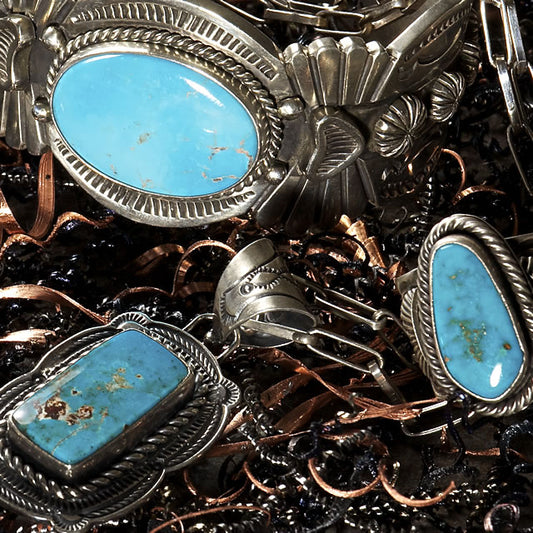About Turquoise
Turquoise
-

-
From geologists to jewelers, miners to healers, ancient cultures to modern collectors, people all over the world have long been fascinated with turquoise. For Native Americans, especially those in the Southwest, this "sky stone" is an ancient talisman for health and well-being, and they have incorporated it into jewelry, carvings, and pottery for centuries, both ceremonial and everyday use. Other cultures also believe it to be one of the most beautiful stones with protective powers. Americans treasure the fact that turquoise comes in so many colors and varieties. In a way, turquoise reflects American culture's emphasis on complexity and diversity, yet on respect for the individual.
Today, nearly all turquoise reaching consumers is sold through the United States. The American Southwest is particularly blessed with the best and most abundant turquoise production. This is where the spiritual values, aesthetic sensibilities and artistry of indigenous peoples have intermingled and co-existed with modern mining and marketing techniques to promote turquoise as a cultural icon around the world.
mine
We will introduce some of the most well-known turquoise mines.

Indian Mountain
A mine in Lander County, Nevada. It was rediscovered in 1970 when a Shoshone shepherd fell. The mine tunnels stretch 46 miles (74 km) from east to west of Crescent Valley. Most of the material is beige in matrix, but dark brown to black is considered to be of higher grade. Currently closed.

Number Eight
It was discovered in northeastern Nevada in 1925 and is now closed. It is mostly pale sky blue with a golden brown matrix, but dark blue is also found. It is relatively easy to distinguish from other types of turquoise due to its distinctive web color and formation.

Bisbee
It was discovered as a by-product of copper mining at the Bisbee copper mine in Arizona. It is the earliest turquoise to be put on the market. It is characterized by a vivid, deep blue color with a purple tint. Some of them contain a unique misty matrix, which is called "Smoky Bisbee". The mine is currently closed.

Kingsmanassa
A mine in Colorado. Discovered by the King family, who came here in search of gold. Blue-green to green with brown and gold non-webbed matrix. The green is especially popular, and the high-grade stones have a translucency reminiscent of porcelain.

Blue Gem
The rough gemstones are found in mines 800 feet underground, and were once sold to jewelers who mass produced loose gemstones. Many early 20th century jewelry pieces feature blue gemstones cut into perfect ovals, circles, and squares. Many high-quality gemstones are in museums and collectors' collections. The mine is currently closed.

Kingman
A mine in Arizona. It was closed in 1970, but mining resumed in September 2004. It comes in a wide range of colors, from greenish blue to a deep, transparent blue. It has similar ingredients to Sleeping Beauty, and the light blue is very similar to it. It is often sold in nugget form.

Lone Mountain
A mine in Nevada. Formerly known as Blue Jay Turquoise. The largest amount of turquoise was produced in 1970. It is so valuable that it is said that the only turquoise that exists is Lander Blue, which is superior to Lone Mountain turquoise. This is based on the low production volume and the high quality that hardly changes or fades. Currently closed.

Morenci
A mine in Arizona. Many high-grade stones were produced from the 1960s to the early 1970s. The bilite matrix is characteristic, and it shines silver when polished. Stones with silver patterns are very expensive and highly valued. Waterweb, which looks like flowing water, is also very popular.



